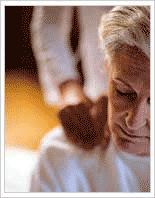

Osteopathy is a manual medicine strongly based on understanding the anatomical and physiological relationships within the body. The process of an osteopathy session is directly related to the specific needs of the client. At the beginning of the session an assessment is done to try to understand the genesis of the presenting problem. From that point forward the osteopath will be working with the structures and tissues whose dysfunction are causing the presenting symptoms. In the case of nervous stress we may be working directly with the nervous system or with the adrenal glands. In the case of chronic musculoskeletal injuries we may be looking at structural alignment of bones and muscles, or chronically shortened fascia, if the problem is visceral we may be looking at enhancing the mobility or vitality of specific organs. In any area of the body we may work to enhance blood flow or nervous conduction to areas with low vitality.
From the clients perspective an osteopathic manual treatment session can vary a great deal. If stress is the issue it can be a profoundly relaxing, releasing, and nourishing experience. If the issue is related to illness or chronic musculoskeletal or postural problems in addition to being therapeutic the experience can be very informative as the client gains knowledge about the possible origin of their symptoms and simple steps such as targeted stretching to help return healthy balance.
Osteopaths treat the whole person, not just the condition. Using the principles of Osteopathy, a wide range of conditions can be treated, including:
* Lower & upper back pain
* Neck pain
* Whiplash
* Disc injuries
* Joint pain
* Arthritis
* Sports injuries
* Tennis Elbow
* Headache and migraine
* Digestive disorders
* Period pain and irregularity
* Recurrent infection
* Sinusitis
* Asthma and chest complaints
* Stress, depression, and fatigue
* General ill health
* Childhood problems.
* Incontinence